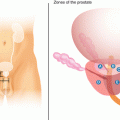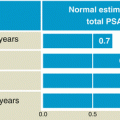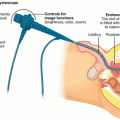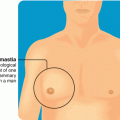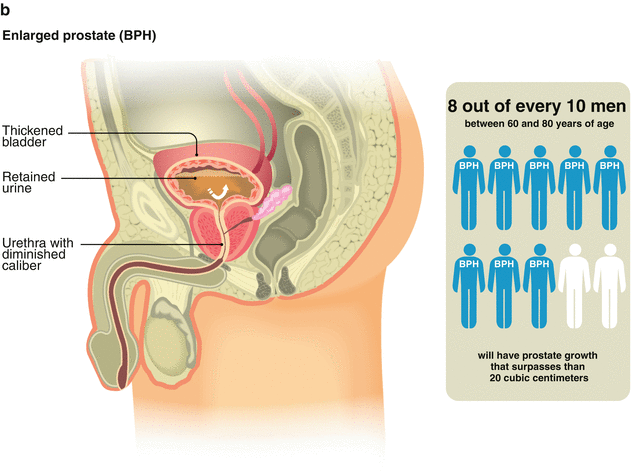
Figure 6.1
(a) Normal prostate. (b) Enlarged prostate
Besides age, other factors have been related to prostate enlargement. Among these are alcoholism and liver cirrhosis, two conditions which increase the concentration of estrogen, a hormone of the blood that stimulates prostate enlargement. Likewise, family history can be another factor indicating risk of benign prostatic hyperplasia, since the sons of patients who have shown this disorder have a risk up to four times greater than other men of developing the disease. In many of these cases, BPH appears at an early age (sometimes before 50 years of age) and the gland can reach a large volume: eight out of every ten men between 60 and 80 years of age will have prostate growth that surpasses 20 cm3 (Fig. 6.1b).
Symptoms
Increase in the size of the prostate does not necessarily cause the same symptoms in all patients, since it has been shown that the appearance of difficulties in urinating is not directly related to its size. That is, there are patients with great difficulty in urinating whose prostate does not show a considerable growth, while others with a noticeable growth of the gland do not develop this problem (Fig. 6.2).
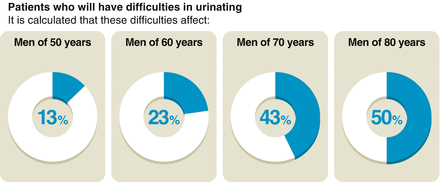

Figure 6.2
Urinary symptoms
In general, benign prostatic hyperplasia symptoms include: thinning and weakening of the urinary flow, difficulty in starting to urinate, and/or intermittent urination or dribbling at the end of the urination. Likewise, there may be an urgent or frequent need to urinate, an increase in urination during the night (nocturia), or the sensation that the bladder does not completely empty after urinating.
There are various explanations for what triggers these symptoms. One of them is that the prostate capsule, which covers the gland like a shell, begins to compress the rest of the organ, causing an increase in the pressure inside the prostate with the consequent difficulty in urinating.
Likewise, the problems have also been attributed to a change in the characteristics of the muscle and fiber cells forming the prostate. The interaction of these cells causes a constant pressure called active and passive tone, which determines the elasticity of the gland. An increase in this pressure, which is transmitted throughout the organ, can also interfere with the flow of urine.
Urinary obstruction can have disastrous consequences, since to compensate for this and to be able to function, the bladder reacts with an increase in the thickness of its walls so as to be able to expel the liquid with greater pressure. Because of this thickening, microscopic changes may appear; these may include the accumulation of fiber or decreased nerve sensitivity, which lead to altered organ function. Storage (filling) symptoms may begin to appear, characterized by the need to urinate more times during the day as well as urinary urgency.
In time, the bladder deteriorates to such a state that it is no longer capable of expelling the urine with sufficient pressure, leading to voiding symptoms: weak urinary stream, the need to push to urinate, etc. A substantial amount of residual urine may remain inside the bladder. This can cause complications such as the growth of bacteria and the resulting urinary infection, or the appearance of bladder stones.
Additionally, the kidneys may also be affected when there is a deficient elimination of urine. In this case, these organs may become dilated (known as hydronephrosis) and their function may deteriorate (chronic renal failure).
Diagnostic Methods
In the presence of symptoms like those described above, it is necessary to consult a specialist, who will inquire about the time of symptom evolution and intensity. The physician will investigate the presence of other symptoms or signs as well, such as: blood in the urine (which might indicate bladder stones or a tumor in the bladder); fever (which may be an indication of a urinary infection); pain in the lower part of the abdomen or behind the testicles (which might be due to prostatitis); a history of urethritis or urethral injury (which could lead to narrowness of the urethra); or a history of neurological disease such as diabetes, stroke, or Parkinson’s disease (that may cause bladder malfunction).
Medical Treatment
One of the things the doctor will try to establish is the degree to which the symptoms are having an impact on the quality of life of the patient, since this will be important at the time of determining the treatment. Also, as of this first consultation, the physician will indicate the laboratory studies and will carry out the explorations considered necessary to learn about the condition of the prostate. These procedures are explained in detail in Chap. 2.
Once benign prostate hyperplasia has been established as the origin of discomfort, it is necessary to follow the treatment as indicated by the physician. The severity of the symptoms will determine the guidelines to follow.
Nevertheless, in those patients with mild symptoms that do not imply an important deterioration in the quality of life, it is possible to simply remain under the observation of the specialist, without needing to take medication. In these cases the patient will need to undergo regular medical checkups (generally every year) to follow the evolution of the symptoms.
The doctor may offer a series of recommendations, such as limiting nighttime intake of liquids, which will help reduce the number of times it is necessary to urinate at night. Also it is advisable to reduce the consumption of certain irritants, such as coffee and alcohol, which can worsen the storage symptoms (urinary urgency and urinating an increased number of times each day). In half of these cases, the symptoms remain stable, without worsening.
As can be seen, the decision to begin a treatment with medication does not depend on the size of the prostate, since this is not necessarily correlated with the inconvenience it produces. In those cases where the symptoms begin to be bothersome, the patients can begin taking medications. These can improve the quality of life and prevent damage to organs such as the bladder and kidneys. However, it must be taken into account that these medications, except in a few cases, do not cure prostate enlargement but only alleviate the symptoms, so if the treatment is suspended, the symptoms will reappear almost immediately.
Alpha Blockers
The symptoms of benign prostate hyperplasia can be related to the contraction of the muscle cells found in the prostate. Like all the cells of the body, those of the prostate have receptors in order to be able to take orders sent by the nervous system. In this case, the order which indicates to the cells that they should contract is received by means of a receptor found on the surface, known as alpha 1 a.
There are medications that block or suspend the activity of this receptor, called alpha blockers. These relax the muscle tone of the prostate and allow the urine to pass easily through the urethra, which is freed from the pressure exercised by the prostate.
At present there are several alpha blockers available on the market. Some commonly prescribed alpha blockers include: Terazosin, Doxazosin, Alfuzosin, Tamsulosin (Flomax), and Rapaflow® (silodosin). The dose prescribed is one tablet once a day, which generally should be taken at night. Alleviation of the symptoms usually begins 48 h after starting the medication. The best possible response is achieved after 2 weeks.
Secondary Effects
In less than 10 % of people taking these drugs, episodes of vertigo, weakness, and dizziness may occur when they make sudden changes in position, such as getting up after having been lying down. One of the effects of the alpha blocker medications is that they can cause a deficiency in the regulation of the blood pressure. The exceptions are Tamsulosin, Alfuzosin, and silodosin, which do not tend to produce this type of alteration.
Alpha blockers do not interfere with erections or with sexual appetite. In less than 10 % of cases, Tamsulosin and silodosin may induce retrograde ejaculation, that is, the semen is not expelled outward but is sent to the bladder and then comes out with the urine. This happens because the drug, which acts on the receptors of the urinary system, keeps the neck of the bladder open during orgasm, causing the sperm from the seminal vesicles and the prostate to take a different path and head toward the bladder rather than outward.
5 Alpha Reductase Inhibitors (5ARIs)
The growth of the glandular cells that cause benign prostatic hyperplasia occurs because of the action of testosterone. However, the real influence on this process occurs from the combined action of the hormone with a protein called 5 alpha reductase, which results in a form known as dihydrotestosterone.
A group of drugs exist to block that protein. When taken, they can reduce the size of the prostate and thereby alleviate the symptoms of the patient. This symptomatic relief is usually more evident in the second month of the treatment.. The greatest reduction in the prostate volume is seen after 6 months. The patients who most benefit from the treatment are those with a prostate volume greater than 40 cm3. The dose is one tablet per day. Some secondary effects reported are diminished sexual interest (4 % of cases), ejaculation disorders (2.7 % of cases), and difficulties with erection (between 1.7 and 3 % of cases).
Fact
Which treatment is more effective to alleviate the symptoms, alpha blockers or 5-ARIs? There are studies that indicate the greater benefit can be obtained with the first group, with observable differences after the seventh day of treatment. This finding can be explained by the fact that 5-ARIs bases its action on the reduction of prostate volume, and, as mentioned, the volume is not correlated with the severity of the symptoms. A recent study suggests that the combination of 5-ARIs plus an alpha blocker is more effective than the use of either one of the drugs alone, but this improvement is achieved only after 1 year of treatment and in patients with large prostate volumes and severe symptoms. Furthermore, this combination has a high cost.
Stay updated, free articles. Join our Telegram channel

Full access? Get Clinical Tree



